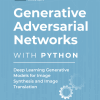Generative adversarial networks, or GANs for short, are an effective deep learning approach for developing generative models. Unlike other deep learning neural network models that are trained with a loss function until convergence, a GAN generator model is trained using a second model called a discriminator that learns to classify images as real or generated. […]










